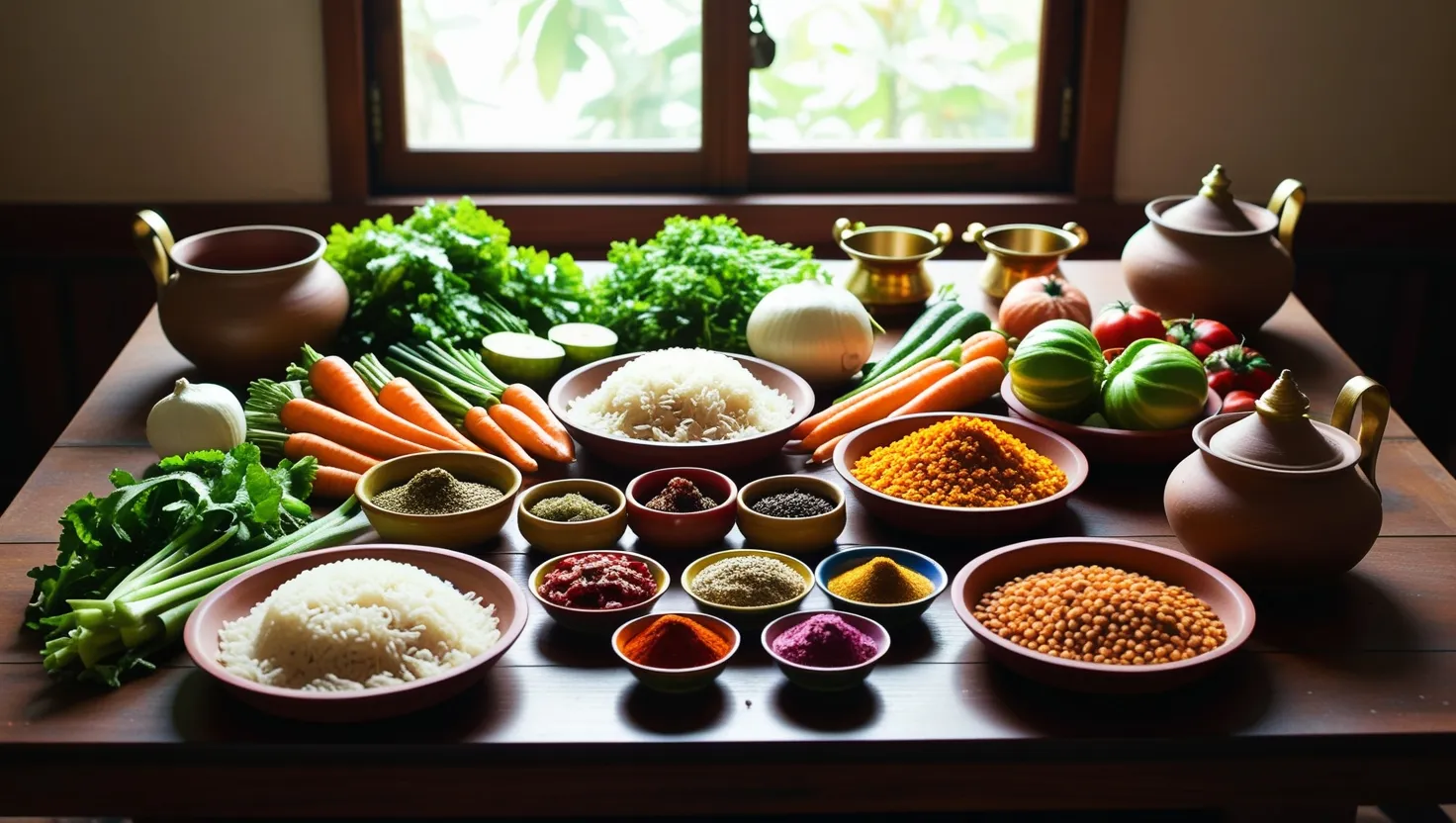To understand why food holds such a central space in Hindu culture, I always like to begin where rituals and daily life meet: the kitchen and the dining mat. Meals in Hindu traditions are more than a way to still the hunger pangs or indulge cravings—they’re a form of meditation, an act of worship, and at times, a language that connects generations. But why does eating, something so ordinary, become so sacred and philosophically significant in this context?
Let’s start with the subtle notion that what I eat quite literally becomes a part of me—body, mind, and consciousness. The Bhagavad Gita draws a striking classification of all food into three categories: sattvic, rajasic, and tamasic. Sattvic foods, fresh and pure, are said to bring clarity. Rajasic foods excite and energize, while tamasic ones dull the senses. This isn’t just ancient taxonomy—it’s a lived practice. When I wake up to the fragrance of freshly steamed rice and vegetables rather than deep-fried snacks, I realize how my mood, thoughts, and even sleep patterns respond in sync.
You might wonder: does it really matter whether I start my day with fruit or with something spicy and rich? According to this philosophy, it matters more than I might think. Sattvic foods are believed to nourish the mind and nurture serene thoughts. Rajasic meals, full of strong spices and stimulants, suit doers—those who thrive on action. But too much of them can turn restlessness into agitation. Tamasic foods, processed or stale, can sap my energy and cloud my head.
There’s a beauty in the notion that mindfulness isn’t restricted to meditation or yoga but extends to every bite I take. As Thich Nhat Hanh, the renowned Zen master, once said,
“When you eat, just eat. When you walk, just walk.”
Hindu tradition takes this a step further: eating is an act of prayer when approached with the right intention.
This brings us to the ritual of prasad: food first offered to the divine before being shared among people. The act of offering changes the meaning of the meal. Suddenly, lunch or dinner isn’t just for me—it’s sanctified, shared, and blessed. Even in crowded temples, when I receive a tiny ball of sweet rice or a piece of fruit, I participate in something greater than my appetite. That morsel embodies gratitude, humility, and a momentary dissolution of ego. Ask yourself: when was the last time you saw a meal as a gift rather than a given?
Fasting, too, is not just abstention but redirection. On Ekadashi, or during Navaratri, millions forgo regular meals, not to punish themselves but to tune inwards and sharpen their focus on prayer. Modern science now echoes ancient wisdom, pointing to the benefits of intermittent fasting for body and mind. But Hindu practice carries it further; the discipline is never empty—it’s filled with intention, self-reflection, and the understanding that saying no to something can often mean saying yes to something deeper.
Vegetarianism’s prevalence in Hindu culture is often explained by ahimsa, the principle of non-violence. This is why, for so many, the dinner plate is the front line of ethical living. Even the act of eating is framed by compassion—not just for animals, but for plants and the planet. This may sound idealistic, but in practice, it colors every kitchen conversation: Can I eat in a way that harms less? Can my lunch be an act of kindness?
The science of Ayurveda takes personalization to another level, tailoring food as medicine. Instead of a standard diet, I’m urged to consider my prakriti—my unique body-mind type. What suits one person may harm another. For instance, I might thrive on a creamy lentil soup, while someone else finds it far too heavy. Understanding my dosha helps me make better choices: cooling foods in summer, warming spices in winter, bitter greens for detox in spring. This respect for cycles—both personal and planetary—echoes through the changing menus from Kerala’s coconut-rich stews to Punjab’s buttery breads.
There’s something quietly revolutionary about how these traditions slip into daily life. Eating slowly, chewing mindfully, savoring each flavor—these practices become a subtle form of meditation. It’s fascinating that thousands of years before “mindful eating” became a buzzword, our ancestors were already teaching it at every meal.
“Let food be thy medicine and medicine be thy food.”
Hippocrates’ words, though ancient Greek, resonate with Ayurvedic wisdom.
I find joy in how communal eating intersects with spiritual values. When temples prepare gigantic cauldrons of rice and curry, serving thousands, an ordinary meal becomes an act of social unity. These gatherings, whether during festivals or daily services, erase boundaries—everyone eats together, regardless of class or status. Food, then, becomes a force for equality and collective joy.
The ecological roots of Hindu food traditions are hard to ignore. Seasonal eating, honoring local produce, and minimizing waste are not just afterthoughts—they’re baked into ritual and routine. The farm-to-table idea that’s so trendy now has deep roots here. Eating what grows nearby, in its right time, was once just common sense. Now, as climate change challenges us to rethink food systems, these old guidelines feel unexpectedly modern.
I often ask myself: Do we truly taste our food anymore, or is eating just another task in a busy day? The act of offering, blessing, and thoughtfully sharing a meal slows me down, giving me a rare, tactile awareness of life’s interconnectedness. There’s a humility in recognizing that nothing I eat reaches my plate without the collaboration of sun, rain, soil, farmers, and cooks.
Hindu food customs don’t shy away from paradox. While some traditions extol asceticism and restraint, others celebrate abundance and richness, especially during festivals. There’s room for street sweets and home-cooked feasts, for fasting and feasting, for quiet solitary prayers and uproarious communal kitchens.
Consider this: In many Hindu homes, the day’s meals are not planned just for taste or convenience but for their subtle effect on mood, posture, and even sleep. Certain foods are avoided at night for their heaviness. Festival dishes are packed with symbolic meanings—sweetness for goodwill, bitterness for life’s learning, tang for vitality.
Even in the modern world, where global brands and instant noodles tempt at every corner, these food philosophies persist in quiet ways. Parents teach children not just how to cook, but how to eat—with attention, gratitude, and respect. This oral tradition ensures that culinary wisdom survives beyond written texts, adapting to new realities and challenges.
“The belly rules the mind.”
This Basque proverb is a gentle reminder that what I consume shapes my outlook, my energy, and even my ability to love and serve.
Sometimes, people see these elaborate food customs as outmoded or overly restrictive. But is there wisdom in ritual? When I pause before a meal, offer a prayer, or share my food, I’m reminded that nourishment isn’t only physical. It is a continuous act of connection: to the earth, to my community, and to something beyond myself.
As I reflect on the timelessness of these traditions, I’m struck by how they resist the uniformity that industrial food culture demands. There’s no one-size-fits-all prescription, no static menu. Instead, there’s a dynamic interplay of climate, creativity, ritual, and ethics. The grandma in Tamil Nadu picking tamarind pods in her backyard and the temple chef in Varanasi stirring a massive pot of khichdi both participate in an ancient dance—balancing sustenance with spirit.
I invite you to think about your next meal: can it become more than fuel? Can it be an offering, a celebration, even a shared moment of quiet consciousness? Hidden in every grain and spice is a story, an intention, a reason to slow down and remember that eating is no less than a sacred act.
“You are what you eat.”
This simple saying gathers new meaning within Hindu traditions, encompassing not only the body but also mind and soul.
Food, then, is so much more than what’s on the plate. It’s an everyday invitation to tune into the rhythms of nature, to honor life in all its forms, and to celebrate the mysterious, profound connection between nourishment and consciousness.






